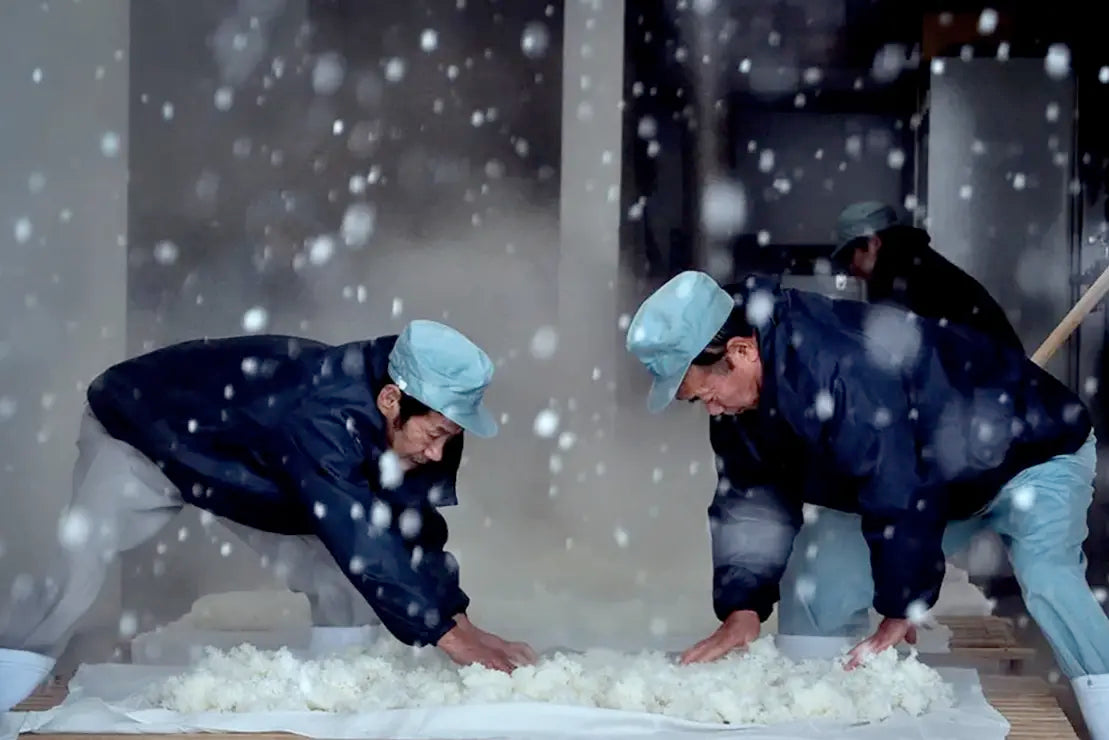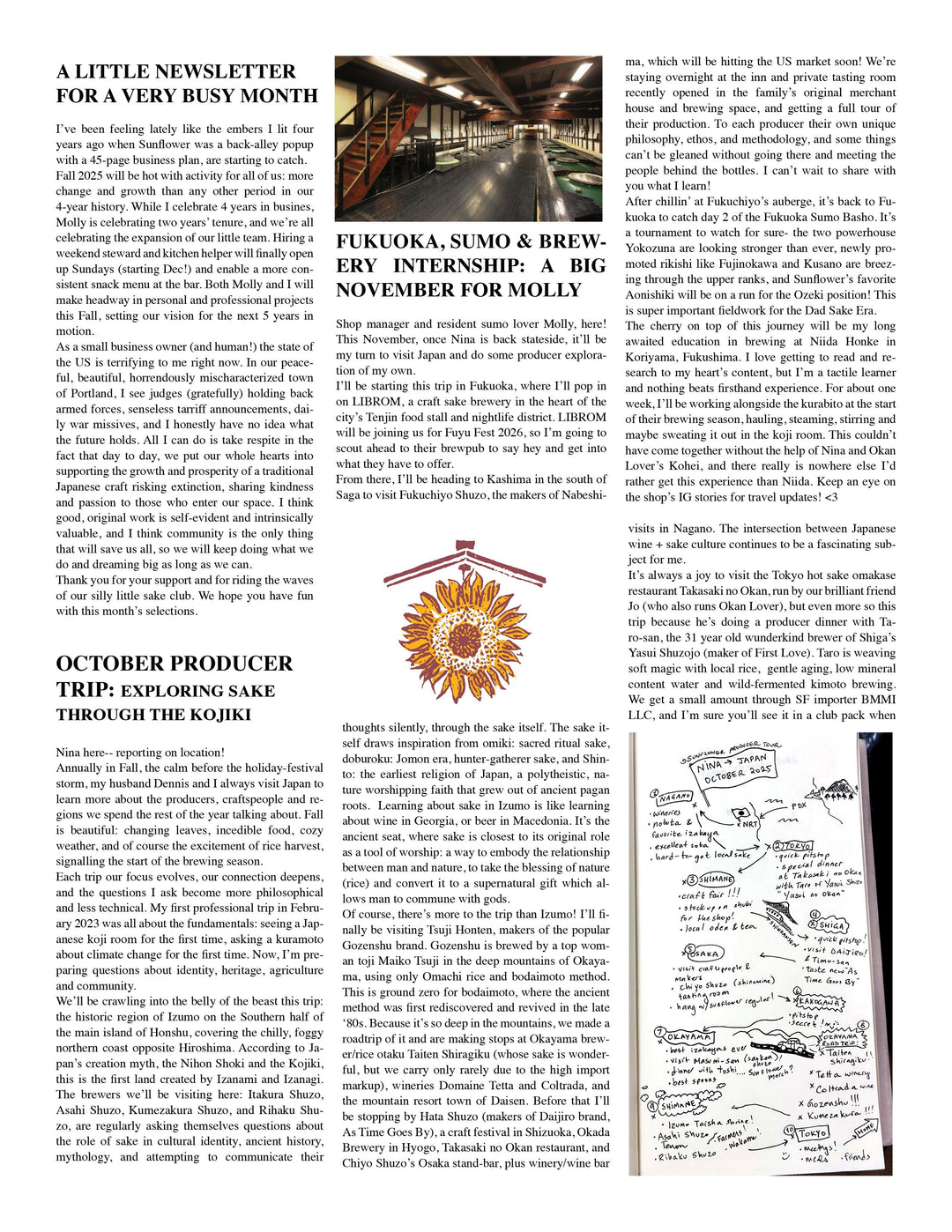SEPTEMBER 2023: Tedorigawa

SUNFLOWER SAKE CLUB
SEPTEMBER 2023
In honor of the wee allocation of Tedorigawa Junmai Yamahai “Unique” I finagled for Oregon this Fall, September’s club highlights Yoshida Shuzo: the sake brewery behind the documentary film, “The Birth of Sake!”
The Birth of Sake, filmed in 2015, left me fascinated by sake in 2016. The film follows Yoshida Shuzo over the course of a Winter brewing season. In the traditional way, brewery workers live on site for 6 months of the year: bunking together, eating together, bathing together, brewing together. There are deeply emotional moments, highs and lows. It is a journey that impresses you with a deep respect for the process. As you enjoy the sake from this month’s club, I strongly encourage you to watch it (on Apple TV or Amazon Prime). This is a quiet, contemplative movie that will make your sake taste even sweeter.

When I visited Yoshida Shuzo (Yoshida is the family name, Shuzo means brewery), makers of Tedorigawa (gawa means river, Tedori is the name of the river) in March 2023 I found a crew deeply inspired by the new, 6th generation president: Yasuyuki (Yasu) Yoshida. He replaced the old, bunk-on-site, 6 day/60+ hour work schedule with a more digestible, 5 day work week. He’s friendly, talkative, inspiring and encouraging. In tandem with his industry peers, Yasu is innovating and pushing new styles onto the market, focused on moderate alcohol and wild fermentation methods inspired by wine. The staff is young, international, excited, and doting. They trust Yasu, admire him, consider him a friend.

This month’s club looks at two different interpretations of elegance under the Yoshida Shuzo banner. Tedorigawa Daiginjo Iki na Onna, which translates roughly to “Lady Luck,” is an interpretation of sake elegance that dates from the previous Yoshida generation. I’ve been lucky to have Master Sommeliers and MS candidates visit my shop, and Iki na Onna captures their sense of ephemeral elegance as only the best burgundy, or daiginjo, can. This sake is produced in limited quantities for the Association for Women Sake Retailers, with a bit extra for the export market. Conspicuously, it could not be purchased at the brewery.
Serve Iki na Onna lightly chilled, within the next ~3-4 months, ideally in a white wine glass. Yasu-san recommends sashimi, sushi, and similarly fresh, delicate flavors with natural sweetness and umami. In his native Ishikawa, blackthroat seaperch (nodoguro), snow crab (zuwaigani), sweet baby shrimp (amaebi) and amberjack (buri) are local specialties. Cucumber with nori tsukudani, ume-shiso, and avocado with wasabi, are excellent vegetarian options.

Iki na Onna is a daiginjo: a highly refined style made with 40% polish (60% removed) Yamadanishiki sake rice grown in Hyogo-- the best, and the one exception Yasu makes for non-local rice. Just before the finished sake is pressed, separating the rice solids from the sake liquid, distilled alcohol is added to the mash, temporarily increasing the alcohol content. This has a few effects: it extracts more alcohol-soluble aromatics and esters from the mash, and when the sake is later adjusted (with water) back to ~15%, those aromatics are higher than they would normally be. The addition of alcohol, which has no real flavor of its own, also dilutes the sake: this increases dryness and makes the flavor more delicate overall. Finally, the alcohol acts a bit like a prism. By diluting the less prominent aromatics and emphasizing others, it creates an impression of clarity: a narrow set of aromatics are conveyed clearly and prominently, while others disappear. In wine, this is often called precision. The resulting sake, a daiginjo (NOT a junmai daiginjo) is a brewery’s best example of its technical mastery. Among top breweries, particularly 15-30 years ago,, daiginjo is considered the most important sake competition category.

Representing modern elegance is Yoshidagura “U” Junmai Yamahai “Unique,” which (in Japan) falls under the brewery’s Yoshidagura brand, not its more famous Tedorigawa brand. Yoshidagura (Yoshida = family name, gura = brewery) is distinct from Tedorigawa in housing Yasu and his team’s innovations. Tedorigawa is the classics, Yoshidagura is the new. In the original Japanese interpretation, “u” means kind, affectionate, yasashii (優しい) as well as “you.” For the English- speaking market, U was translated to Unique and the Tedorigawa brand is used to ensure brand consistency. (Image credit: Japanese retailer kagataya.net)
Yoshidagura is where Yasu explores new styles and flavors, but more importantly, endeavors to address the issues facing the sake industry: declining consumer interest, energy consumption (cold storage, production), and lack of regional identity. “U,” with its strong regional identity, more natural- but also modern– techniques, and fresh and low alcohol style, considers these issues thoughtfully.
One of the cornerstones of Yoshidagura sake, including Unique, is to use the yamahai brewing method. Yamahai relies on ambient microorganisms to facilitate the first stage of fermentation, where acidity is increased through the action of lactic acid bacteria. In Ishikawa prefecture, the Noto school of master brewers in the area were reputed for yamahai-style sake, and this technique has been passed down for many generations. Here, yamahai is facilitated by the high mineral content of the water and the cold Winter temperatures. Yoshida Shuzo produces lots of yamahai sake, but is distinctive for its very clean yamahai style. Typically, yamahai is associated with funky, gamey, earthy, mushroomy notes, but at Yoshida Shuzo, it is much lighter, brighter– more modern.

Pictured above is a brewing tank which has been topped with ice. This is a batch of modern-style yamahai at Yoshida Shuzo. By keeping the fermentation very cold, and doing their water additions with ice instead of liquid water, they can ensure that “U” has notes of pink grapefruit, banana and yogurt, delicate minerality, and only a hint of enoki mushroom belying the method. The use of house yeast (a relative of the mild local Kanazawa yeast, aka Yeast #14) and local Ishikawamon rice (a local offspring of the more famous Gohyakumangoku) affirms the notion of regionality, or terroir. Finally, the sake is carefully brewed to reach 13% ABV at the end of fermentation, making it a genshu, or undiluted sake, at a naturally moderate ABV.
The result, Yasu hopes, is a style of sake that will resonate with younger drinkers, the same way natural wine has done for the global wine market. It has a sense of place, bright acidity and freshness, drinks elegantly from a wine glass, pairs well with international cuisine, and the alcohol content is relatively low. As a fan of natural wine and having cultivated international tastes from promotion and travel activities, Yasu admits it’s the style he prefers to drink, finding 15-16% ABV sake too strong. Can’t say I agree, but I do love “u” for its gentle affect. The relatively high acidity and crisp fruit tones are a natural pair for oily fish (mackerel, herring, salmon, hamachi) or dishes which play off of the citrus notes: grilled vegetables with a lemon-olive oil dressing, delicate proteins dressed with a coriander salad, gazpacho– particularly peach gazpacho– with herb oil, and the starters that come before the sushi (little salads, edamame, fresh tofu) in a classic omakase meal.
But if you want to do it Ishikawa style, or more specifically Hakusan style, prepare a batch of TKGY: Tamagokake Gohan Yaki for your Tedorigawa & Birth of Sake movie night. TKGY is a rice dish invented by the youth group of the Tsurugi Chamber of Commerce and Industry to promote the town by using its local products such as rice, water and shoyu. TKGY was named by taking the first letter of "Tamago Kake Gohan Yaki," and is a pan fried rice cake: super easy to prepare, and absolutely delicious. I made these for Birth of Sake Movie Night last December 2022 and I’ve made them many times since for myself as a snack.

As you can see above, technically, there are three rules to cook TKGY, but here in Oregon we have to do our best. First, the rice must be produced in Ishikawa Prefecture, washed and cooked with river-bed water from Hakusan (strike one and two). Second, it must be cooked with brewed products from Ishikawa Prefecture: shoyu, miso, sake and vinegar (strike three). Third, it must be prepared while reciting the slogan "T"sugaru "K"ara "G"enkito "Y"ukiwo! (good spirits and courage from Tsugaru!) which you absolutely can do.
TKGY Recipe
Wash and prepare 1 cup of Japanese short-grain white rice, then let it cool thoroughly. You don’t want it hard from being in the fridge overnight, but a little firm is OK. I recommend cooking the morning before you prepare these in the evening.
Mix the prepared rice with 1 large egg, 1 t shoyu, and enough dashi (or water, seasoning with a little dashi powder if you have it) to make the mixture sticky like a thick pancake batter, Around 1-2 tablespoons. Let sit for 30 minutes.
While the mixture sits, prepare your sauce. In a pan over medium heat, warm together ⅓ c good quality shoyu, 2 T mirin (preferably hon mirin), 1 T rice vinegar and 2 T sake (use a savory or cooking junmai, not one of the ones shared in this pack!). Add a little more mirin if you like it a bit sweeter. Simmer for 3-4 minutes, enough to cook some of the alcohol off but not to reduce too much. Remove from heat and let cool. Chop green onion, and get your nori strips or flakes ready. Not shown in the photo, but TKGY is damn good with kewpie mayo too.
Preheat a frying pan or griddle with oil to medium heat. Using a ring mold (if you like it neat) or just dolloping freely, griddle cakes about ¼- ⅓ cup in size. Flip when they start to get golden. Once both sides are golden, remove from heat and brush with your sauce, topping with green onion, aonori, and kewpie. Relax and enjoy with a glass of sake.




